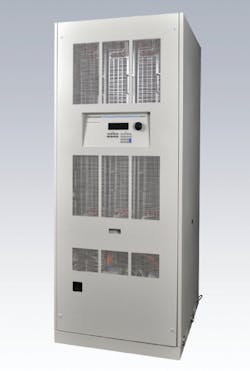The Energy Systems Integration Facility (ESIF) on the campus of the U.S. Department of Energy’s National Renewable Energy Laboratory in Golden, Colorado obtained a new system to be used for grid simulation in the test and evaluation of advanced energy systems such as micro-grids and renewable energy inverters. A key feature of the simulation system is the ability to present the device under test (DUT) with anomalous grid conditions.
A regenerative 1 MVA AC + DC source system from Amatek Programmable Power, maker of programmable AC and DC power test solutions. is at the heart of the system. The unit is based on Ametek’s California Instruments RS Series High-Power AC source.
The Energy Systems Integration Facility will be the nation’s first facility able to conduct integrated megawatt-scale research and development of the components and strategies needed to safely move clean energy technologies onto the electrical grid. While the facility will support R&D efforts that span the entire electric power system, it will focus on electric systems, buildings and facility systems, community power generation and microgrids; utility generation, thermal and hydrogen systems, energy efficient and advanced grid technologies; electricity system architectures, interoperability; and utility generation and grids that incorporate renewable energy (solar, wind, hydrogen, and advanced vehicles).
The new 12-chassis test solution, dubbed the RS1M, consists of four RS270 systems from Ametek. Each system is defined as three 90kVA chassis. Each RS270 system is capable of generating 270 kVA of 3 ø power at up to 692 Vac (L-L). Four control chassis allow ESIF engineers to remotely configure the entire solution as a single 1 MVA, two 540 kVA, four separate 270 kVA, or one 810 kVA and one 270 kVA system. According to an Ametek spokesman, this capability will give ESIF the flexibility it needs to size the simulated power grid appropriately for the devices being tested, as well as understand how different renewable energy technologies interact with each other in a distributed generation micro-grid.
The RS Series source has a built-in capability to generate the grid anomalies needed for testing. But, to support the ESIF's hardware-in-the-loop (HIL) simulation requirements, the RS1M was customized to allow ESIF engineers to control it in real time via external drive signals. These modifications bypass the system controller to permit the external signals to directly control the high-power source, thus eliminating any control signal delays.
Hardware-in-the-loop simulation is not a new concept, but adding megawatt-scale power "takes research to another level," said the spokesman. "ESIF’s Smart Power Lab will use the HIL simulators for research and development of the power electronics components, circuits, and controls used in clean and sustainable energy integration. This allows researchers and manufacturers to conduct component and system tests at full power and actual load levels in real-time," he added.
About the Author
Renee Bassett
Managing Editor

Leaders relevant to this article:
